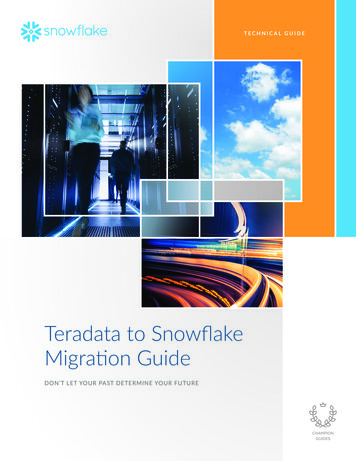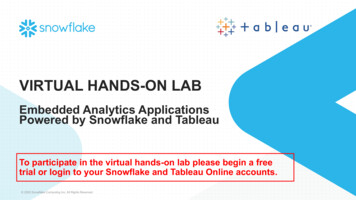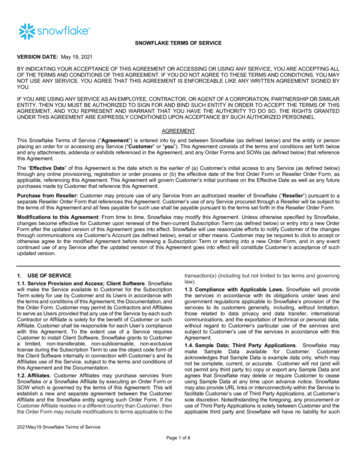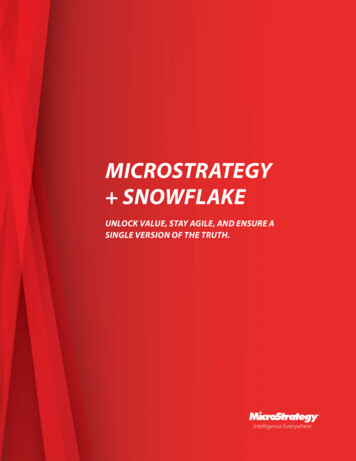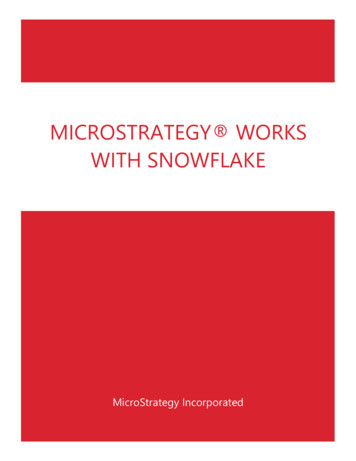
Transcription
MICROSTRATEGY WORKSWITH SNOWFLAKEMicroStrategy Incorporated
TABLE OF CONTENTS0INTENT OF THIS DOCUMENT . 21OVERVIEW . 31.11.22RELEASE HIGHLIGHTS . 42.12.23MICROSTRATEGY. 3SNOWFLAKE. 3MICROSTRATEGY 2021 . 4MICROSTRATEGY 2020 . 4TECHNICAL CONSIDERATIONS WITH SNOWFLAKE . 53.1FEATURE SUPPORT . 53.1.1SSO . 63.1.2OAuth 2.0 . 63.1.3Kerberos . 63.1.4SAML . 73.1.5Parameterized Queries . 73.1.6Data Import. 73.1.7Live Connect. 83.1.8Arrow Format . 83.2PERFORMANCE . 93.2.1Using VARCHAR Size When Creating Tables . 93.2.2Query Performance Comparison of Old DBMS vs Snowflake . 93.2.3Driver Optimization . 103.2.4Connection Caching . 113.2.5VLDB Properties . 113.2.6Lookup Cube Caching . 123.2.7Snowflake Specific Tuning . 123.3CONNECTIVITY . 133.3.1MicroStrategy Official Documentation. 133.3.2Available Drivers. 13Which Driver is Best Suited? . 133.3.3Data Flow Diagram . 144COMMON ERRORS DEBUGGING WITH MICROSTRATEGY AND SNOWFLAKE. 154.1DEBUGGING MICROSTRATEGY AND SNOWFLAKE . 154.1.1Unix Charset Issue . 154.1.2Debugging Initial DB Connection Time and Connection Caching . 154.2ADDITIONAL QUESTIONS . 164.3ENHANCEMENT REQUESTS . 16 2021 MicroStrategy.1
0 INTENT OF THIS DOCUMENTThe intent of this document is to give an overview of different technical aspects to consider whenintegrating MicroStrategy with Snowflake.This document was created by thorough research and customer site visits to understand differentcustomers’ use cases of Snowflake with MicroStrategy. This document briefly summarizes commonchallenges with their resolutions and provides reference links for detailed information.Note: MicroStrategy and Snowflake are both changing rapidly. If you encounter a situation where thedocument is not valid, please let us know and we will update it.Author: Talhah Zafar (PM)Collaborators: Marcin Graczyk (ES), Sergio Sainz (TEC), Yang Huang (TEC), Chris Van Huis (Snowflake)Date of Original Creation: 2021Q1Last Update: 2021Q1 2021 MicroStrategy.2
1 OVERVIEW1.1 MicroStrategyMicroStrategy is the leading enterprise business intelligence tool with its mission statement to makeevery enterprise a more intelligent enterprise.Learn more at MicroStrategy.1.2 SnowflakeConventional data warehouses weren’t designed to keep up with the exploding demand for data-driveninsight at modern organizations. With years of experience building the world most performantdatabases, Snowflake founders were in a unique position to see this problem, and how cloud could solveit. In 2012, they founded Snowflake with the simple intention of enabling the worlds organizations to bedata driven. With a brand-new architecture for a data platform designed to take advantage of cloudelasticity and simplicity, they created Snowflake.A few key features: Very easy to use Near zero infrastructure Secure & highly available No indexes, distribution keys, partitioning, or vacuuming Data storage is columnar compressed and encrypted Only pay for what is used: Scale compute up and down and take advantage of multipleworkloads simultaneouslyLearn more at Snowflake.1.3 MicroStrategy and Snowflake Better TogetherYou can learn more about MicroStrategy’s Integration with Snowflake from “MicroStrategy Workswith Snowflake” session. 2021 MicroStrategy.3
2 RELEASE HIGHLIGHTS2.1 MicroStrategy 2021 12% OOTB Performance Improvements with Implicit Table Type Creation. OIDC Support for Snowflake. Unified Quoting Updates to better handle characters. 30% Performance Improvement with Lookup Cube Caching.2.2 MicroStrategy 2020 Up to 3X Performance Improvements OOTB using Derived Table Syntax and Arrow DataTransfers. Connectivity Wizard Support for Snowflake ODBC & JDBC drivers shipping OOTB. Ship latest JDBC driver with Arrow Format enabled. OAuth Support of Snowflake with Okta and Azure AD. SSO Support of Snowflake with Azure AD. 2021 MicroStrategy.4
3 TECHNICAL CONSIDERATIONS WITH SNOWFLAKE3.1 Feature supportWhen migrating existing applications to Snowflake, certain MicroStrategy capabilities are leveragedwith tight integration of the databases. It is important to understand that certain capabilitiespowering the user workflows might not be supported in Snowflake.Below are the common database workflows MicroStrategy customers face when dealing esOAuth 2.0YesYesKerberosNoYesSAMLYesYesParameterized QueriesYesYesData ImportYesYesLive ConnectYesYesArrow FormatYesYesMaterialized ViewsYesYesSearch OptimizationYesYesBinary Data TypeYesYes 2021 MicroStrategy.5
3.1.1 SSOSingle Sign-On (SSO) allows for one-time login for both MicroStrategy and Snowflake.Impact: AuthenticationMotivation: One-time loginDetails: MicroStrategy currently support SSO with Azure AD. After the Administrator sets up SSO, theyonly have to login once and take advantage of both MicroStrategy and Snowflake from the samecredentials.To learn more about this functionality, please take advantage of the Integrating MicroStrategy withSnowflake for Single Sign-On using Azure AD documentation.3.1.2 OAuth 2.0OAuth 2.0 is becoming very widely used these days and is one of the most common authenticationmethods out there.Impact: AuthenticationMotivation: Use non-native authenticationDetails: MicroStrategy supports both Azure AD and Okta Authentication with Snowflake. Once theadministrator sets it up, the end user has to just log in with their Okta or Azure AD email credentialsto start using MicroStrategy with Snowflake.MicroStrategy OAuth 2.0 workflow with Okta can be seen here. Please follow this product guide toimplement OAuth 2.0 with MicroStrategy.3.1.3 KerberosKerberos helps with authentication.Impact: AuthenticationMotivation: Customers want to leverage Kerberos authentication for their infrastructureDetails: Snowflake doesn’t support Kerberos and the Snowflake customers are directed to use SAMLauthentication instead. 2021 MicroStrategy.6
3.1.4 SAMLSAML helps with authentication.Impact: AuthenticationMotivation: Customers want to leverage SAML authentication for their infrastructureDetails: Snowflake supports SAML authentication. Please refer to this documentation to takeadvantage of SAML authentication .3.1.5 Parameterized QueriesMicroStrategy's support for parameterized queries can improve performance in scenarios that requirethe insertion of information into a database.Impact: Performance, securityMotivation: Customers can write data into tables fasterDetails: Parameterized queries are SQL queries that can use placeholders for data. Using placeholdersallows these queries to be re-used. A common application of this re-usability is to combine multipleinserts of data into a database as a single query. The following is an example of a parameterizedquery: INSERT INTO DMTABLE (Customer ID, Customer Name) VALUES (?, ?) Combining multipleINSERT statements into a single query can improve the performance of inserting data into thedatabase.Starting in MicroStrategy 2021 Update 1, parameterized queries are turned on by default.3.1.6 Data ImportMicroStrategy supports data import with Snowflake.Impact: CapabilityMotivation: Customers can bring in data as a cache so they can save on costs using SnowflakeDetails: With the Data Import functionality, MicroStrategy imports data from Snowflake into its fastin-memory cubes and can constantly send queries to the data in the memory saving on computecosts. Unlike most traditional warehouses, result fetching is optimized in Snowflake for cubes, so noadditional tooling is required for bulk imports. Although Snowflake caches query results for up to 24hours on their side, MicroStrategy has the capability of storing the data for much longer dependingon the refresh interval. 2021 MicroStrategy.7
Example: Updating cache once a month, using aggregated data, and saving on the cost by notquerying data frequently in Snowflake. Use a cube with MicroStrategy if you're only concerned withlast month’s aggregated data. The cube can answer most daily questions instead of going back toSnowflake.3.1.7 Live ConnectMicroStrategy support live-connect with Snowflake.Impact: CapabilityMotivation: Customers can create ad-hoc visualizationsDetails: With live connect functionality, customers can create ad-hoc visualization with Snowflakewithout importing the data back into MicroStrategy. Most customers take advantage of quickresponse time offered by dossiers or reports by querying a direct and concise slice of data utilizingthe power of Snowflake.Example: Use live connect if you're trying to look at certain transaction details, such as transactionsbetween 11:20AM UTC – 11:25AM UTC that originated from Virginia, and the product categoryElectronics.3.1.8 Arrow FormatArrow Format helps with performanceImpact: PerformanceMotivation: Customers can access data fasterDetails: Arrow format is an internal Snowflake performance improvement and doesn’t affect customerworkflows. At the time of publishing this document, only the current JDBC driver supports the Arrowformat functionality. ODBC driver doesn’t support arrow format, but Snowflake plans to roll out anupdate to support it in the near future. MicroStrategy 2021 can take advantage of Arrow Formatprovided by Snowflake which can help improve the performance for customers. Description andbenchmarks are available here. 2021 MicroStrategy.8
3.2 PerformancePerformance is an important consideration with MicroStrategy and Snowflake. MicroStrategy createsoptimized SQL for Snowflake and it is always recommended to be on the latest MicroStrategy releaseto take advantage of the most optimal performance. Below are some performance considerationswhich will help you achieve better performance with MicroStrategy.3.2.1 Using VARCHAR Size When Creating TablesQueries can have a significant increase in the fetch time when there are tables containing VARCHARwithout specifying a size in Snowflake. Performance degradation occurs because the MicroStrategyIntelligence Server uses an ODBC call (SQLDescribeCol) to determine the proper resources to allocatefor the query results of VARCHAR columns. In anticipation of resources, a large memory will beallocated for a small amount of data (even if the string is only a few hundred characters maximum).VARCHAR (16777216) will set the limit for more size and will affect performance while fetching. Evenif the tables are created, you can alter the VARCHAR size. Please refer to KB441548 to learn moreabout it.3.2.2 Query Performance Comparison of Old DBMS vs SnowflakeAlways use a similar hardware in Snowflake to your old DBMS solution if you’re doing performancecomparisons. For best performance analysis, make sure you’re performing apple-to-applecomparisons when comparing your old DBMS to Snowflake.For example: Queries tend to run faster in a powerful on-premise warehouse compared to a smallinstance of Snowflake. To match performance, please increase the instance size of Snowflake.Please refer to this Snowflake blog to learn about comparing on-premise to cloud data platform.Learn more about different Snowflake warehouse considerations on the Snowflake documentationpage. 2021 MicroStrategy.9
3.2.3 Driver Optimization3.2.3.1ODBC vs JDBCIn MicroStrategy MicroStrategy 2021, both ODBC and JDBC are shipped out of the box.Based on our internal benchmarks, JDBC connection shows better performance than ODBCconnection. See the test result in the following (Figure 1).One major reason is the adoption of Apache Arrow with the release of Snowflake JDBC drivers. Youcan read more about Snowflake’s usage of Apache Arrow here.Fetching result sets JDBC driver now leverages the Arrow columnar format to avoid the overheadpreviously associated with serializing and deserializing Snowflake data structures which are also incolumnar format.As of early 2021 Snowflake is in the process of adding Arrow support to the ODBC drivers. ContactSnowflake for more details.3.2.3.2Fetch Size OptimizationMicroStrategy only recommends this setting for cases when customers are having performance issuesduring ingestion of MicroStrategy cubes. MicroStrategy performed some internal testing on the fetchsize and published KB484894.You can enable this setting by modifying the connection string used in Intelligence Server DatabaseConnections tab under the Additional parameters field. The following is an example connection string:JDBC;DRIVER {net.snowflake.client.jdbc.SnowflakeDriver};URL mputing.com/?warehouse YOUR WAREHOUSE&useProxy true&proxyHost YOUR HOST&proxyPort 8080};FETCHSIZE 1000; 2021 MicroStrategy.10
3.2.3.3ODBC API Calls for Warehouse CatalogMicroStrategy also supports using API calls to retrieve catalog information. However, due to the slowperformance of Snowflake driver’s metadata operations, this option is generally not recommended. TheSnowflake API call we used, for example, get Tables (null, null, ), by default returns all tables in alldatabases and schemas. Luckily, there is a setting on the Snowflake server side:CLIENT METADATA REQUEST USE CONNECTION CTX. Read more about it here.Setting this parameter to true would narrow the search scope to the current database and schema by theconnection context.3.2.4 Connection CachingIn MicroStrategy, there is a setting to keep the cache of the database connection. With this optionenabled, MicroStrategy will cache the connection for the Snowflake warehouse. This will in returnsave couple of seconds every time a report is run as MicroStrategy and Snowflake doesn’t have tocreate the connection again. This option is set by default for MicroStrategy customers.Snowflake on the other hand also has a setting to keep the client connection alive. It is recommendedto have it enabled to save on the time for connection creation.To learn more about keeping your connection active, please read the FAQs for the ODBC/JDBCdrivers. To learn more about the session parameters, please refer to the Snowflake documentation.3.2.5 VLDB PropertiesMicroStrategy constantly optimizes the queries and sets new defaults for the VLDB properties socustomers can take advantage of the best performance possible. It is recommended to always stay onthe latest MicroStrategy release so you can always have the best Snowflake experience OOTB.Based on our customer insights, we have seen some performance improvements after tweaking someVLDB settings. There is no such thing as “One Size fits all” recommendation so please modify thesesettings responsibly. With the below VLDB settings, some customers achieved a 22%-36%performance improvements on pure snowflake SQL Execution. However, users should be aware of thefact that every implementation is different, and we give an idea where to look to increaseperformance. JoinBase Table Join for Template Use Fact Table JoinFrom Clause Order Move MQ Table in normal FROM clause order to the last (for RedBrick)Full Outer Join Support Outer-Join 2021 MicroStrategy.11
Pre/Post StatementsDrop Database Connection Do not drop database connection after running user defined SQL[when using pre/post SQL] Query OptimizationSub Query Type WHERE COL1 IN (SELECT s1.COL1.) falling back to EXISTS (SELECT col1,col2 .) for multiple columns INTransformation Formula Optimization Always join with transformation table to performtransformation Select/InsertDistinct/Group by option Use GROUP BYGROUP BY Non-ID Attribute Use Group By TablesFallback Table Type Use Permanent tableIntermediate Table Type Derived TablesTable Creation Type Implicit3.2.6 Lookup Cube CachingEvery customer can take advantage of the lookup caching cube to improve report and cubeperformance by up to 30% against the data warehouse. Please refer to Improving Report and CubePerformance to learn more about it.3.2.7 Snowflake Specific TuningSnowflake provides a query profile page which you can use to investigate your queries. For general tuningof Snowflake, please take advantage of the snowflake tuning page. 2021 MicroStrategy.12
3.3 ConnectivityConnectivity is typically the biggest concern among customers. To better assist MicroStrategycustomers, MicroStrategy has created documentation with the latest information.3.3.1 MicroStrategy Official DocumentationView the MicroStrategy documentation, How to Connect to Snowflake with MicroStrategy.The following Snowflake documents provide other relevant configuration and usage information thatpertain to each driver: JDBC Driver ODBC Driver3.3.2 Available DriversStarting in MicroStrategy 2020 Update 2, the Snowflake ODBC driver is shipped to simplify theconnectivity workflow. In MicroStrategy 2021, MicroStrategy ships Snowflake JDBC out of the box.JDBC is more performant than the ODBC.Always be aware of the latest driver version using the Snowflake release notes.3.3.3 Which Driver is Best Suited?MicroStrategy recommends using the JBDC driver for Snowflake because MicroStrategy customershave constantly seen JDBC driver outperform the ODBC driver. The Snowflake JDBC driver is built inhouse by Snowflake and tends to get the latest updates before the ODBC counterpart, developed bySimba. 2021 MicroStrategy.13
3.3.4 Data Flow DiagramODBCJDBC 2021 MicroStrategy.14
4 COMMON ERRORS DEBUGGING WITH MICROSTRATEGY ANDSNOWFLAKE4.1 Debugging MicroStrategy and Snowflake4.1.1 Unix Charset IssueThis usually arises when installing drivers directly from the Snowflake website instead of theMicroStrategy-provided drivers.Issue: MicroStrategy displays partial catalog names (e.g., database, schema, table)Solution:1. Click Database Instance Modify the Database connection Advanced tab.2. Configure the Database Connection in MicroStrategy Administrator to UTF-8.Note: If the customer is using MSTR Intelligence Server on Linux/Unix they should do the opposite ofthe recommendation from the above. That is, choose non-UTF8 for Unix.4.1.2 Debugging Initial DB Connection Time and Connection CachingWhen working with Snowflake (which might be like other Cloud databases) we found an additionaldelta time of up to 2 seconds to establish a JDBC database connection compared to on preminstallations. This time is required for spawning the JDBC wrapper and driver thread, completing theCloud OSCP Certification check, and establishing proxy connection. How to detect that time:In MicroStrategy Developer, the report SQL View shows this time as "Total Other Processing time" insummary and as "Other Processing Time" in the first SQL Pass. How to avoid:By default, MicroStrategy uses database connection caching. After a report is run, we keep theconnection open (DB connection timeout values apply). If the same user requests another report, wereuse this connection, avoiding initial connection time. Caveat when using PreSQL:In our customer case, MicroStrategy initially prevented connection caching as the customer usedsome PreSQL for use schema or alter sessions to comment the query. As we could alter a session in 2021 MicroStrategy.15
such a way that it effects further reports, MicroStrategy drops a connection after a report, that usedPre or Post SQL, has finished. One VLDB setting for Connection Cache:There is another VLDB Setting (check Advanced settings first) in the Pre/Post Statements section.Drop Database Connection Do not drop database connection after running user defined SQL [whenusing pre/post SQL]With that we can cache the connection with improves performance for subsequent report executionsthat can reuse the connection.4.2 Additional QuestionsPlease reach out to the MicroStrategy or Snowflake community site.4.3 Enhancement RequestsPlease log a case for MicroStrategy. 2021 MicroStrategy.16
Below are some performance considerations which will help you achieve better performance with MicroStrategy. 3.2.1 Using VARCHAR Size When Creating Tables Queries can have a significant increase in the fetch time when there are tables containing VARCHAR without specifying a size in Snowflake. Performance degradation occurs because the MicroStrategy
